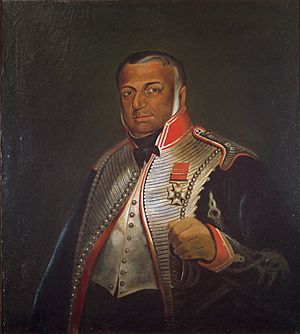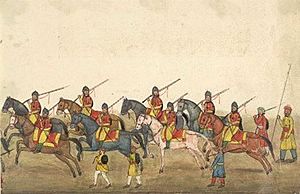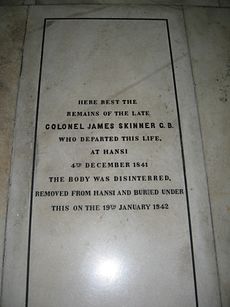James Skinner (East India Company officer) facts for kids
Quick facts for kids
James Skinner
|
|
|---|---|
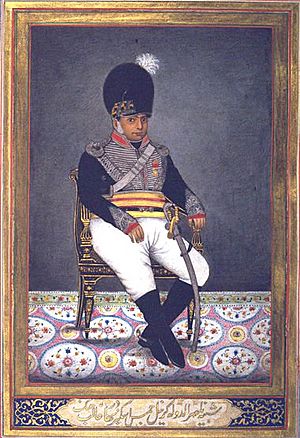
James Skinner, from his Tazkirat al-Umara (Account of the Nobles of Delhi and its neighbourhood)
|
|
| Nickname(s) | Sikandar Sahib |
| Born | 1778 Calcutta, Bengal Presidency |
| Died | 4 December 1841 (aged 62–63) Hansi, Bengal Presidency |
| Service/ |
Maratha Army (1796–1803) Bengal Army (1803–1841) |
| Rank | Colonel |
| Unit | Skinner's Horse |
| Battles/wars | Second Anglo-Maratha War Third Anglo-Maratha War |
Colonel James Skinner (1778 – 4 December 1841) was an amazing soldier from India. He served in both the Maratha Empire army and the Bengal Army of British India. People knew him as Sikandar Sahib. He is most famous for creating two special cavalry groups, called regiments, for the British in 1803. These groups, known as 1st Skinner's Horse and 3rd Skinner's Horse, are still part of the Indian Army today!
James Skinner was very good at Persian, which was an important language for educated people in India back then. He wrote several books in Persian. One of his books, Kitāb-i Tashrīḥ al-Aqvām, had many beautiful pictures and described the different groups of people in India. This book is now kept at the Library of Congress.
Contents
Early Life and Education
James Skinner was born in 1778 in Calcutta, India. His father, Lieutenant-Colonel Hercules Skinner, was a Scottish officer in the East India Company army. His mother, Jeany, was an Indian aristocrat. She was captured at a young age and later cared for by his father. They had seven children together.
James first went to an English school in Calcutta. In 1794, he was sent to a boarding school to continue his education.
A Soldier's Career
James Skinner's father first tried to get him a job as a printer. But James didn't like it and ran away after only three days! Because his mother was Indian, James could not become an officer in the East India Company army. So, at 16, he joined the Maratha army as an ensign. He served under French commanders like Benoît de Boigne and Pierre Cuillier-Perron. James quickly showed he was a talented soldier.
In 1803, when the Second Anglo-Maratha War began, all Anglo-Indian soldiers had to leave the Maratha army. James then joined the Bengal Army of the East India Company.
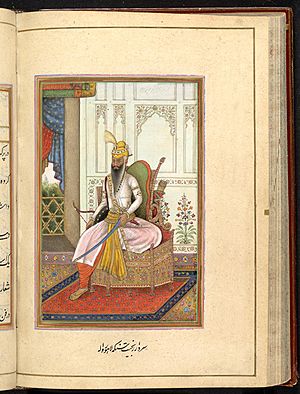
On February 23, 1803, James Skinner created a new cavalry regiment. It was called "Skinner's Horse" or the "Yellow Boys" because of their bright yellow uniforms. This group became a very famous part of the British Indian Army. It still exists today as part of the Indian Army. Skinner led his regiment in important battles, including the Siege of Bharatpur in 1805 and the Pindari War (1817–1819). For his great service, he was given land in Hansi that earned him a lot of money each year.
In 1828, James Skinner was finally made a lieutenant-colonel in the British army. Later, he became a colonel. He also received an important award called the Companion of the Order of the Bath in 1826.
Other Contributions
James Skinner knew a lot about the people and cultures of India. Important leaders like the governor-generals and commanders-in-chief often asked for his advice. He also ordered many paintings to be made in the Company style.
Skinner wrote a book of his military adventures in Persian. It was called Tazkirat al-umara. This book included stories about royal families in Sikh and Rajput areas. It also had 37 portraits of their leaders.
Building St. James' Church
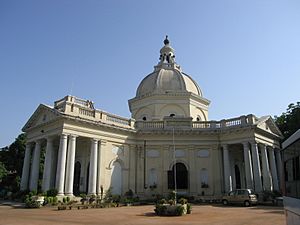
James Skinner built St. James' Church, also known as Skinner's Church, in Delhi. He had promised to build a church if he survived being wounded in a battle in 1800. He paid for the church himself, and it cost a lot of money.
The church was designed by Major Robert Smith and built between 1826 and 1836. It has a cross shape, with three porches and a round dome in the middle. It was officially opened on November 21, 1836. This makes it the oldest church in Delhi. James Skinner is also said to have built a temple and a mosque, but we don't know much about them.
Skinner died in Hansi on December 4, 1841, when he was 64 years old. He was first buried in Hansi. But after 40 days, his coffin was moved to Delhi. It was brought by 200 men from Skinner's Horse. He was then buried in a white marble tomb inside St. James' Church on January 19, 1842.
Skinner's Family
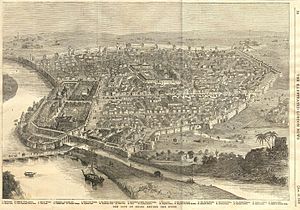
James Skinner had a large family. He had many children. One of his daughters, Mrs. Wagentreiber, was able to escape the Indian Rebellion of 1857. This was because the Indian Army regiments respected James Skinner so much. His oldest son, Hercules Skinner, became an officer. Another son, James Skinner, also joined Skinner's Horse. Sadly, he was killed in a battle during the First Anglo-Afghan War. Many of his family members are buried in the Skinner family plot, which is north of St. James' Church in Delhi.
James Skinner was a good friend of William Fraser and his brother James Baillie Fraser. James Baillie Fraser wrote a book about Colonel James Skinner's military life.
Skinner's Descendants
One of James Skinner's grandsons, also named James Skinner, paid for a statue of Queen Victoria to be put up in Chandni Chowk, Delhi, after she died.
In 1960, Lt-Col Michael Skinner, who was James Skinner's great-great-grandson, took command of Skinner's Horse. He was the first Skinner to lead the regiment since its founder died! In 2003, a special service was held at St. James' Church, Delhi to celebrate 200 years of Skinner's Horse. Patricia Sedwards, a niece of Lt-Col Michael Skinner, was among those present.


